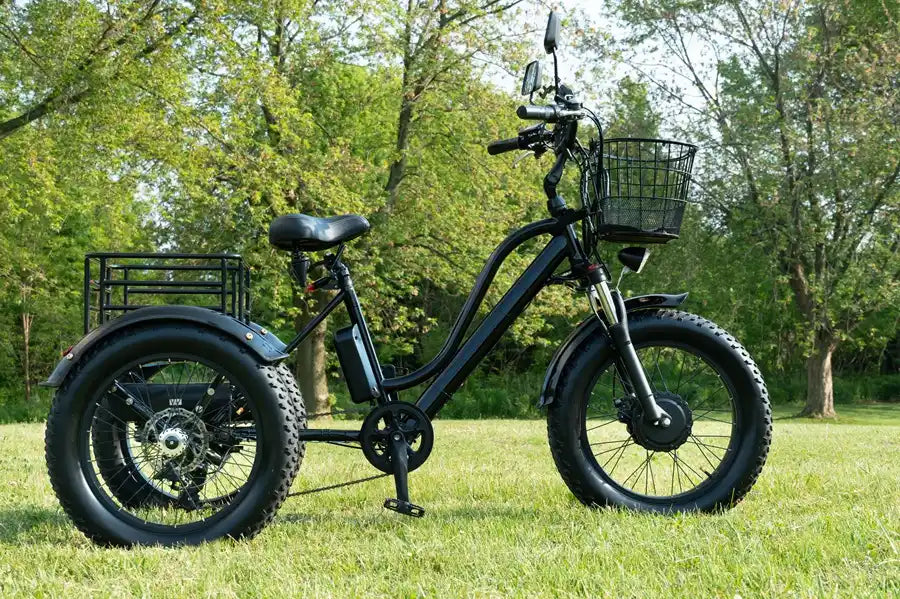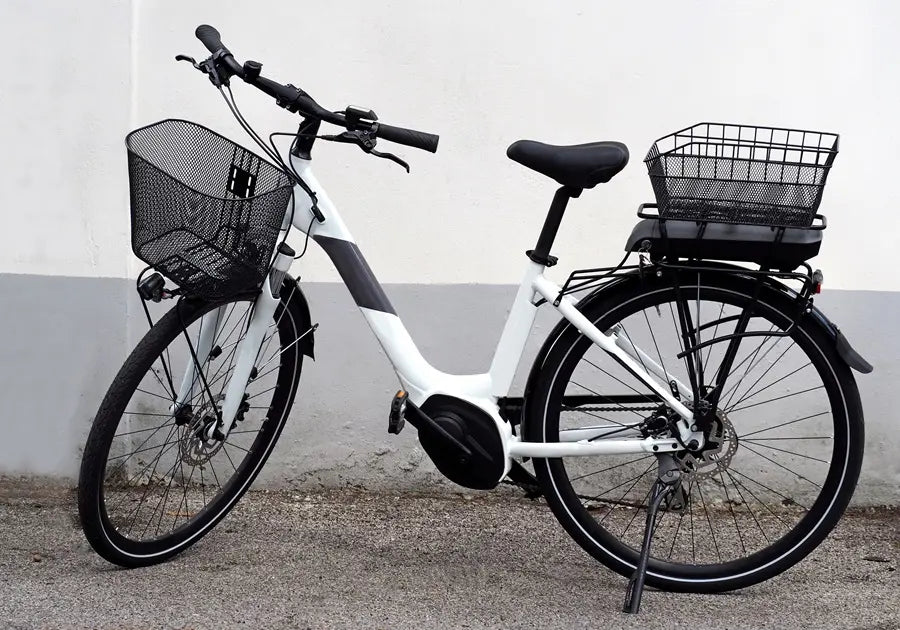With so many e-bike options available today, choosing the right one can be kind of confusing, especially when you don’t know the differences between them. One factor you'll see is fat-tire e-bikes vs thin-tire e-bikes. Not sure what that means? No worries, this guide from our team at eBikeling will delve into the key differences between these two types of e-bike tires to help you select the perfect fit for your needs.
What Is a Fat-Tire Electric Bike?
Fat tire e-bikes, also known as fat tire electric bikes, boast wide, balloon-like tires typically ranging from 3 to 5 inches in width. These oversized tires provide superior traction and stability on a variety of terrains, including sand, snow, and mud. Their lower air pressure limits contribute to a smoother ride by absorbing bumps and shocks more effectively.
What Is Fat-Tire Biking Ideal For?
Off-Road Terrain
Fat-tire e-bikes are the undisputed champions of conquering challenging landscapes. Whether you're traversing rocky trails, sandy beaches, or snowy paths, fat tire e-bikes provide the grip and stability you need to navigate these rough surfaces with confidence.
All-Weather Flexibility
Fat tire e-bikes are truly all-weather machines. Their wide tires can handle anything from loose gravel to snow, making them ideal for year-round riding.
What Are the Benefits of Fat-Tire E-Bikes?

Fat tires make your e-bike travel seamless, agile, and hassle-free.
Excellent Grip
The wider surface area of fat tires provides superior traction on loose surfaces like sand, gravel, or snow. This wider footprint digs into the terrain, giving you more control and confidence while riding, especially when taking corners or navigating loose surfaces.
Better Shock Absorption
Fat tires boast lower air pressure limits and a larger volume compared to thin tires. This translates to a noticeably smoother ride, as the tires can absorb bumps and shocks more effectively. You'll feel less fatigue on rough terrain and enjoy a more comfortable ride overall.
More Floatation
Imagine gliding effortlessly over sand or snow. Fat tires excel at floating over soft surfaces, preventing you from getting stuck. This makes them perfect for exploring beaches, snowy trails, or conquering soft, technical terrain that would bring a regular tire bike to a halt.
Increased Stability
The wider footprint of fat tires offers enhanced stability, particularly beneficial for beginner riders or those navigating challenging terrain. The increased contact patch with the ground provides a more surefooted feel, inspiring confidence and making it easier to maintain balance.
Puncture Resistance
Say goodbye to flats. The thicker construction of fat tires makes them less susceptible to punctures from debris on the road or trail. This means less time spent fixing flats and more time enjoying the ride. You can explore confidently without worrying about unexpected tire woes interrupting your adventure.
What Are the Disadvantages of Fat-Tire E-Bikes?

As a rule, pros and cons go hand in hand together. Here's a breakdown.
Heavier Weight
There's no such thing as a free lunch, and the wide girth of fat tires comes with a weight penalty. Fat tires and the reinforced components needed to support them contribute to a heavier overall bike weight. This extra weight can make the bike feel less maneuverable and can slightly decrease acceleration compared to a lighter thin-tire e-bike.
Lower Top Speed
Due to the increased weight and rolling resistance of fat tires, fat-tire e-bikes typically have lower top speeds compared to their thin-tire counterparts. This may not be a dealbreaker for casual riders or those prioritizing comfort and off-road capability, but it's worth considering if speed is a major concern.
Higher Rolling Resistance
The wider surface area of fat tires creates more friction with the ground as they roll. This results in higher rolling resistance, which can slightly decrease efficiency and range compared to thin-tire e-bikes. In simpler terms, you might need to recharge your battery slightly more often with fat tires.
Bulkier Storage
Wide tires take up more space. Fat tire e-bikes can be less convenient for storing in tight spaces or transporting on bike racks. They may require a bike rack specifically designed to accommodate wider tires. However, as long as you have a foldable fat-tire e-bike – Rydy Model I, storage and transportation on public transport are no problem.
What Is a Thin-Tire E-Bike?

Thin-tire e-bikes, also known as regular-tire e-bikes or skinny-tire e-bikes, sport narrower tires typically ranging from 1 to 2 inches wide. These e-bikes prioritize speed and efficiency on paved surfaces.
What Are Thin Tires Ideal For?
Commuting
Thin-tire e-bikes are a popular choice for commuting due to their lighter weight, higher speeds, and efficient performance on paved roads.
Racing
Thin-tire e-bikes are specifically designed for racing and high-performance riding, offering minimal rolling resistance and a lightweight build for maximum speed.
What Are the Benefits of Thin-Tire E-Bikes?
Lighter Weight
Thin tires and a lighter overall build translate to a more maneuverable and easier-to-handle bike. This makes them ideal for navigating tight spaces, quick acceleration, and easier handling, especially for riders who value agility and speed.
Higher Speed
Less weight and lower rolling resistance allow thin-tire electric bikes to achieve faster speeds compared to fat-tire e-bikes. This makes them a great choice for commuting, racing, or riders who prioritize getting from point A to point B quickly and efficiently.
Efficiency
Thin tires offer lower rolling resistance due to their narrower profile. This translates to more efficient use of battery power, potentially resulting in a slightly longer range on a single charge. For riders concerned about maximizing the distance they can travel on a single battery charge, thin tires offer an advantage.
What Are the Drawbacks of Thin-Tire E-Bikes?

Limited Terrain
Thin tires are simply not suited for off-road riding. They lack the traction and stability needed to navigate rough terrain like loose gravel, sand, or snow. While they may handle light bumps on paved paths, venturing off-road on a thin-tire e-bike can be a bumpy, slippery, and frustrating experience.
Reduced Shock Absorption
The thinner profile and higher air pressure requirements of thin tires mean they offer less shock absorption compared to fat tires. This results in a bumpier ride on uneven surfaces, which can be fatiguing on longer rides. Riders who prioritize comfort, especially on less-than-perfect road conditions, may find thin tires a bit harsh.
Lower Puncture Resistance
The thinner profile of regular tires makes them more prone to punctures from debris on the road. This can be a concern for riders who explore paths with a higher likelihood of encountering sharp objects.
Here’s a table summary of the advantages and disadvantages of fat-tire and thin-tire e-bikes.
| Feature | Fat-Tire E-Bikes | Thin-Tire E-Bikes |
|---|---|---|
| Terrain | Handles rough terrain well (sand, snow, mud). | Performs best on paved surfaces. |
| Speed | Slower acceleration and top speed. | Faster acceleration and top speed. |
| Comfort | More comfortable ride due to better shock absorption. | Less comfortable ride due to thinner tires. |
| Grip | Generally better due to wider contact patches and deeper treads. | Good on smooth surfaces, but may struggle off-road. |
| Stability | More stable due to a wider contact area with the ground. | Less stable due to narrower contact area. |
| Flotation | Superior due to wider surface area and lower air pressure. | Inferior due to narrower surface area and higher air pressure. |
| Puncture Resistance | More puncture resistant due to thicker tires and lower air pressure. | Less puncture resistant due to thinner tires and higher air pressure. |
| Maneuverability | Less maneuverable due to wider tires. | More maneuverable due to narrower tires. |
| Rolling Resistance | Higher and requires more effort to overcome tire deformation. | Lower and less energy is lost due to tire deformation. |
| Battery Life | May have a shorter battery life due to working harder on rough terrain. | May have longer battery life due to less rolling resistance. |
| Storage | More difficult to store due to wider tires. | Easier to store due to narrower tires. |
| Weight | Heavier due to thicker tires and sturdier frames. | Lighter due to thinner tires and lighter frames. |
| Price | Generally more expensive. | Generally cheaper. |
5 Reasons Why Fat Tires Are Better (For Many Riders)
While both fat-tire and thin-tire e-bikes have their merits, fat tires offer some compelling advantages for a wider range of riders:
- Versatility: Fat tire e-bikes are truly all-terrain vehicles. They conquer challenging off-road terrain with ease, but they also perform admirably on paved surfaces. While not the fastest on smooth roads, they offer a comfortable and stable ride for casual cruising.
- Top comfort: The increased air pressure limits and larger volume of fat tires translate to a significantly smoother ride. This is especially noticeable on bumpy roads or gravel paths. If comfort is a priority, fat tires are the clear winner.
- Confidence on every ride: The superior grip and stability of fat tires inspire confidence, especially for new riders or those venturing onto unfamiliar terrain. You'll have better control and traction in loose gravel, corners, or even light snow.
- Year-round fun: Don't let bad weather stop you! Fat tire e-bikes are built to handle anything Mother Nature throws at you. They’re the best electric bikes for snow, sand, and mud, allowing you to extend your riding season and explore year-round.
- Puncture resistance: Flats can ruin a ride. The thicker construction of fat tires makes them less susceptible to punctures from debris on the road or trail. This means less time spent fixing flats and more time enjoying the ride.
Conclusion
Ultimately, the choice between a fat-tire e-bike and a thin-tire e-bike depends on your riding style and priorities. If you crave adventure and conquering diverse terrains, a fat tire e-bike is your perfect match. For riders who prioritize speed, efficiency, and smooth commutes on paved roads, a thin-tire e-bike might be the better option.
For many riders who crave versatility, comfort, and confidence, fat-tire e-bikes offer a compelling package that allows you to explore further, ride longer, and fully experience the joy of e-biking. So, browse our shop or contact us to choose your fat-tire e-bike (or transform your regular bike into a powerful electric one with one of our conversion kits) and accessories, hit the trails, and discover the freedom of electric biking on any terrain!





